RENAULT TWINGO RS 2009 2.G Electrical Equipment - Airbags And Pretensioners Workshop Manual
Manufacturer: RENAULT, Model Year: 2009, Model line: TWINGO RS, Model: RENAULT TWINGO RS 2009 2.GPages: 67, PDF Size: 0.3 MB
Page 1 of 67

8Electrical equipment
V3 MR-413-X44-88C000$TOC.mif
V3
88C
"The repair procedures given by the manufacturer in this document are based on the
technical specifications current when it was prepared.
The procedures may be modified as a result of changes introduced by the
manufacturer in the production of the various component units and accessories from
which his vehicles are constructed."
V3
All rights reserved by Renault s.a.s.
Edition Anglaise
Copying or translating, in part or in full, of this document or use of the service part
reference numbering system is forbidden without the prior written authority of
Renault s.a.s.
© Renault s.a.s. 2009
AIRBAGS AND PRETENSIONERS
MRSZ AIRBAG
Vdiag: 04
Fault finding - Introduction 88C - 2
Fault finding - List and location of components 88C - 7
Fault finding - Operating diagram 88C - 14
Fault finding - Function 88C - 16
Fault finding - Replacement of components 88C - 18
Fault finding - Configurations and programming 88C - 19
Fault finding - Fault summary table 88C - 21
Fault finding - Interpretation of faults 88C - 22
Fault finding - Conformity check 88C - 61
Fault finding - List of Statuses and parameters 88C - 64
Fault finding - Customer complaints 88C - 65
Fault finding - Fault Finding Chart 88C - 66
Page 2 of 67
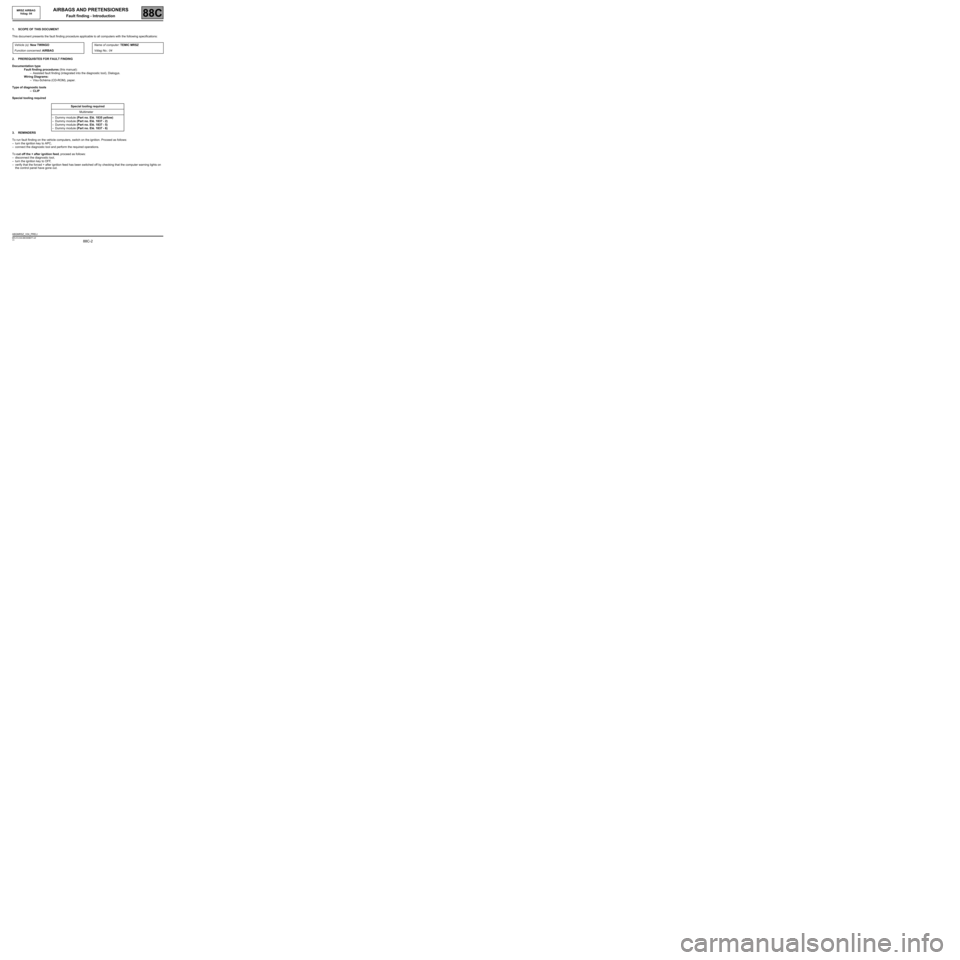
88C-2
MR-413-X44-88C000$077.mif
V3
88C
AIRBAGS AND PRETENSIONERS
Fault finding - Introduction
1. SCOPE OF THIS DOCUMENT
This document presents the fault finding procedure applicable to all computers with the following specifications:
2. PREREQUISITES FOR FAULT FINDING
Documentation type
Fault finding procedures (this manual):
–Assisted fault finding (integrated into the diagnostic tool), Dialogys.
Wiring Diagrams:
–Visu-Schéma (CD-ROM), paper.
Type of diagnostic tools
–CLIP
Special tooling required
3. REMINDERS
To run fault finding on the vehicle computers, switch on the ignition. Proceed as follows:
–turn the ignition key to APC,
–connect the diagnostic tool and perform the required operations.
To cut off the + after ignition feed, proceed as follows:
–disconnect the diagnostic tool,
–turn the ignition key to OFF,
–verify that the forced + after ignition feed has been switched off by checking that the computer warning lights on
the control panel have gone out. Vehicle (s): New TWINGO
Function concerned: AIRBAGName of computer: TEMIC MRSZ
Vdiag No.: 04
Special tooling required
Multimeter
–Dummy module (Part no. Elé. 1835 yellow)
–Dummy module (Part no. Elé. 1837 - 2)
–Dummy module (Part no. Elé. 1837 - 5)
–Dummy module (Part no. Elé. 1837 - 6)
ABGMRSZ_V04_PRELI
MR-413-X44-88C000$077.mif
MRSZ AIRBAG
Vdiag: 04
Page 3 of 67
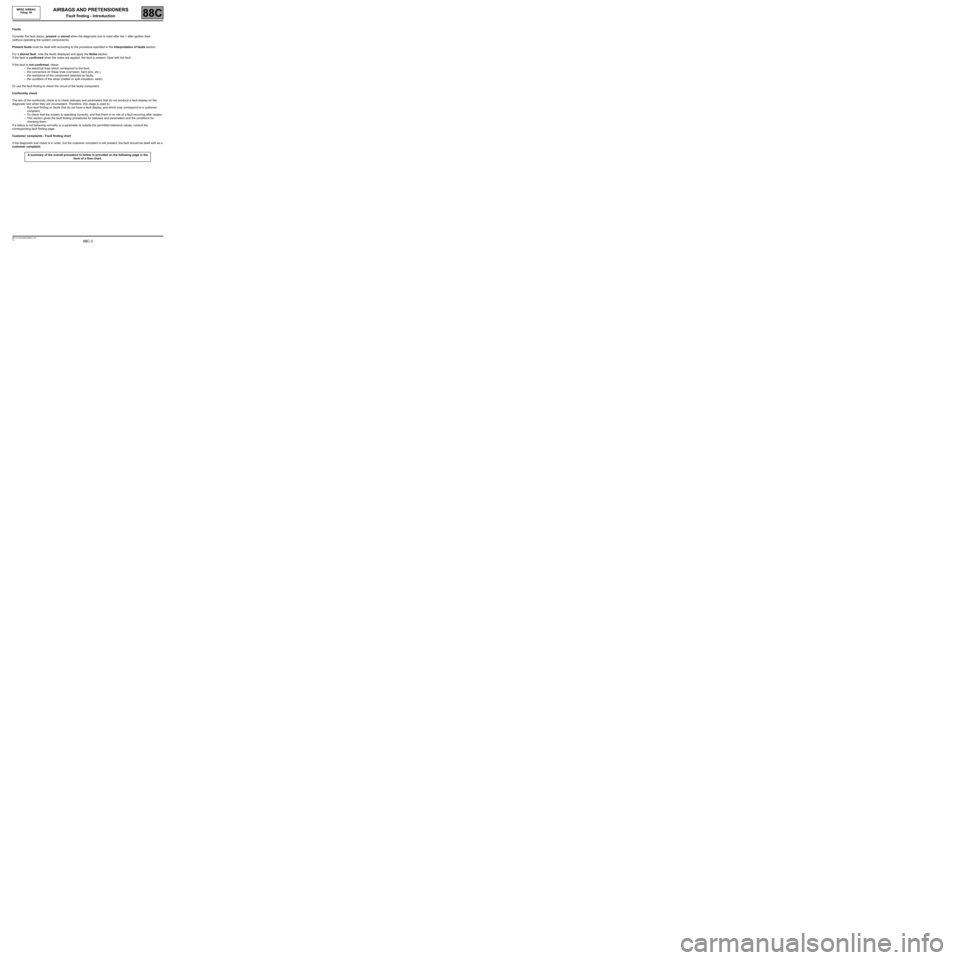
88C-3
MR-413-X44-88C000$077.mif
V3
MRSZ AIRBAG
Vdiag: 04AIRBAGS AND PRETENSIONERS
Fault finding - Introduction88C
Faults
Consider the fault status, present or stored when the diagnostic tool is used after the + after ignition feed
(without operating the system components).
Present faults must be dealt with according to the procedure specified in the Interpretation of faults section.
For a stored fault, note the faults displayed and apply the Notes section.
If the fault is confirmed when the notes are applied, the fault is present. Deal with the fault
If the fault is not confirmed, check:
–the electrical lines which correspond to the fault,
–the connectors on these lines (corrosion, bent pins, etc.),
–the resistance of the component detected as faulty,
–the condition of the wires (melted or split insulation, wear).
Or use the fault finding to check the circuit of the faulty component.
Conformity check
The aim of the conformity check is to check statuses and parameters that do not produce a fault display on the
diagnostic tool when they are inconsistent. Therefore, this stage is used to:
–Run fault finding on faults that do not have a fault display, and which may correspond to a customer
complaint,
–To check that the system is operating correctly, and that there is no risk of a fault recurring after repairs.
–This section gives the fault finding procedures for statuses and parameters and the conditions for
checking them.
If a status is not behaving normally or a parameter is outside the permitted tolerance values, consult the
corresponding fault finding page.
Customer complaints - Fault finding chart
If the diagnostic tool check is in order, but the customer complaint is still present, the fault should be dealt with as a
customer complaint.
A summary of the overall procedure to follow is provided on the following page in the
form of a flow chart.
Page 4 of 67
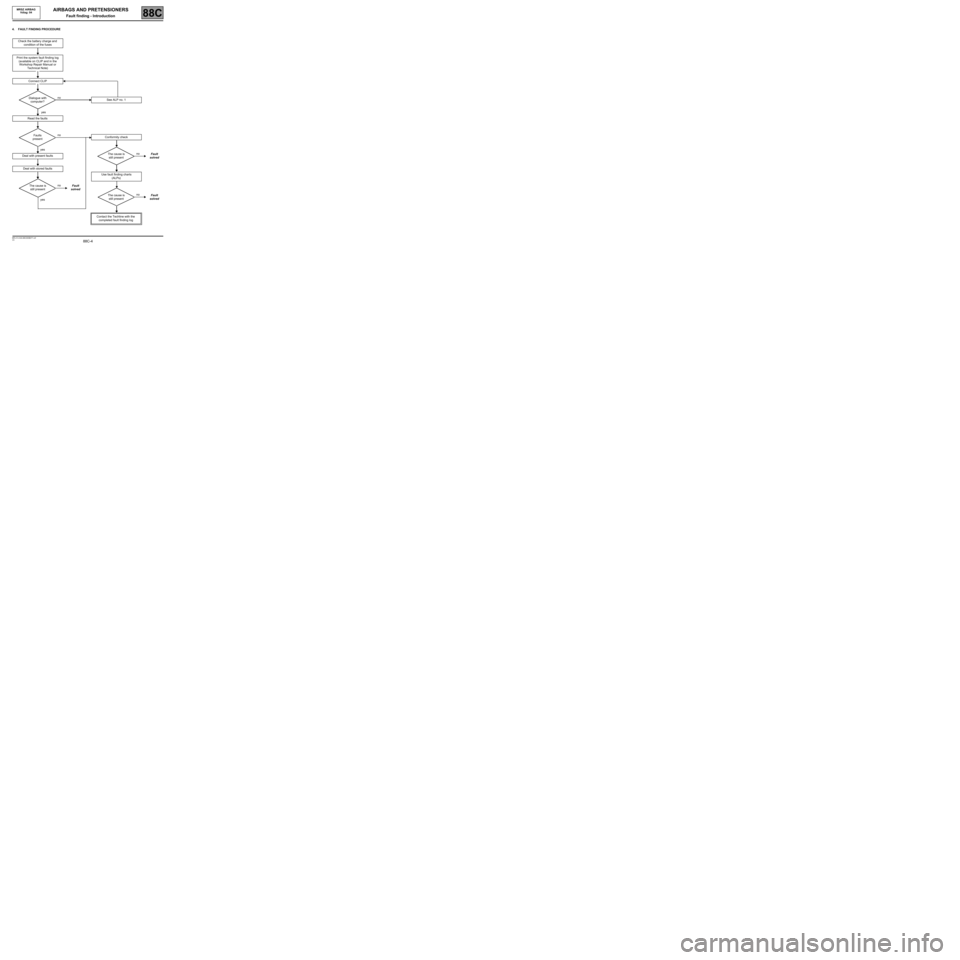
88C-4
MR-413-X44-88C000$077.mif
V3
MRSZ AIRBAG
Vdiag: 04AIRBAGS AND PRETENSIONERS
Fault finding - Introduction88C
4. FAULT FINDING PROCEDURE
Check the battery charge and
condition of the fuses
Print the system fault finding log
(available on CLIP and in the
Workshop Repair Manual or
Technical Note)
Connect CLIP
no
Dialogue with
computer?
yes
Read the faults
no
Faults
present
yes
Deal with present faults
Deal with stored faults
no
The cause is
still presentFault
solved
yes
See ALP no. 1
Conformity check
no
The cause is
still presentFault
solved
Use fault finding charts
(ALPs)
no
The cause is
still presentFault
solved
Contact the Techline with the
completed fault finding log
Page 5 of 67
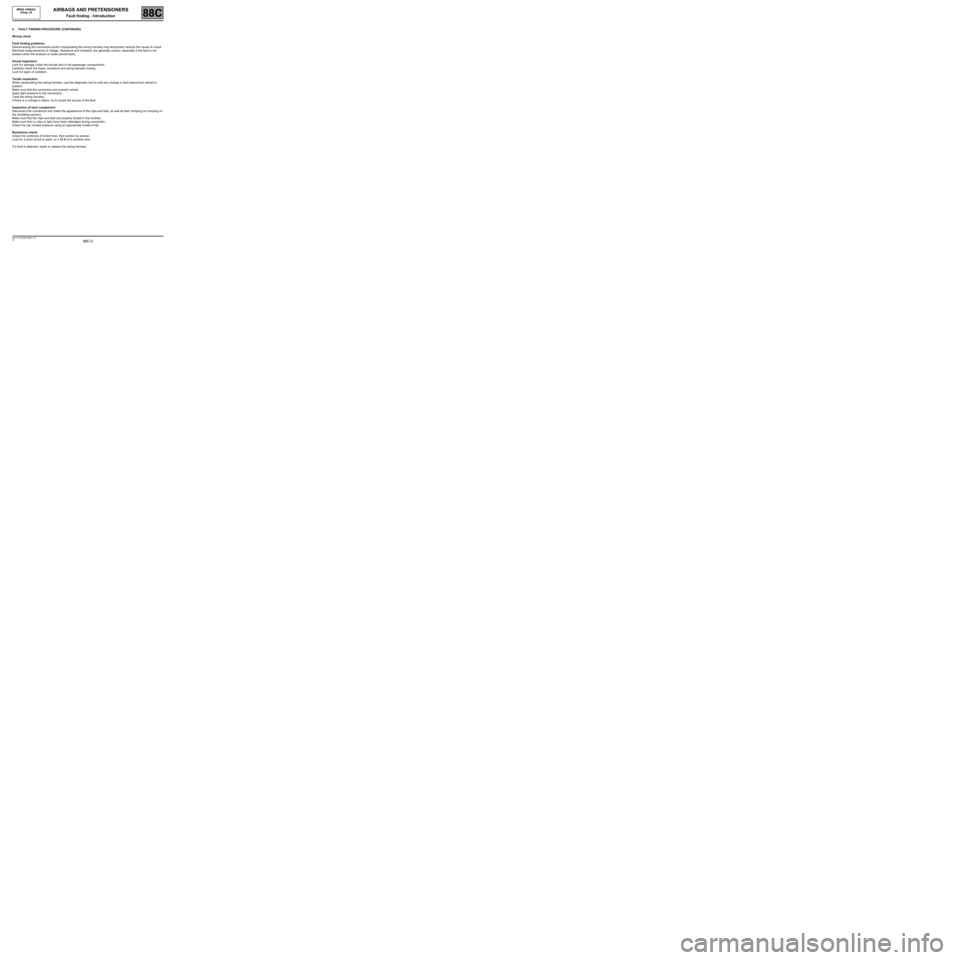
88C-5
MR-413-X44-88C000$077.mif
V3
MRSZ AIRBAG
Vdiag: 04AIRBAGS AND PRETENSIONERS
Fault finding - Introduction88C
4. FAULT FINDING PROCEDURE (CONTINUED)
Wiring check
Fault finding problems:
Disconnecting the connectors and/or manipulating the wiring harness may temporarily remove the cause of a fault.
Electrical measurements of voltage, resistance and insulation are generally correct, especially if the fault is not
present when the analysis is made (stored fault).
Visual inspection:
Look for damage under the bonnet and in the passenger compartment.
Carefully check the fuses, insulators and wiring harness routing.
Look for signs of oxidation.
Tactile inspection:
While manipulating the wiring harness, use the diagnostic tool to note any change in fault status from stored to
present.
Make sure that the connectors are properly locked.
Apply light pressure to the connectors.
Twist the wiring harness.
If there is a change in status, try to locate the source of the fault.
Inspection of each component:
Disconnect the connectors and check the appearance of the clips and tabs, as well as their crimping (no crimping on
the insulating section).
Make sure that the clips and tabs are properly locked in the sockets.
Make sure that no clips or tabs have been dislodged during connection.
Check the clip contact pressure using an appropriate model of tab.
Resistance check:
Check the continuity of entire lines, then section by section.
Look for a short circuit to earth, to + 12 V or to another wire.
If a fault is detected, repair or replace the wiring harness.
Page 6 of 67

88C-6
MR-413-X44-88C000$077.mif
V3
MRSZ AIRBAG
Vdiag: 04AIRBAGS AND PRETENSIONERS
Fault finding - Introduction88C
5. FAULT FINDING LOG
You will always be asked for this log:
●when requesting technical assistance from Techline,
●for approval requests when replacing parts for which approval is mandatory,
●to be attached to monitored parts for which reimbursement is requested. The log is needed for warranty
reimbursement, and enables better analysis of the parts removed
.
6. SAFETY INSTRUCTIONS
Safety rules must be observed during any work on a component to prevent any damage or injury:
Check the battery voltage to avoid incorrect operation of computer functions.
During work on the airbag/seat belt pretensioner systems, it is vital that you lock the computer using the
diagnostic tool to prevent any risk of accidental triggering (all the trigger lines will be disabled).
The locked mode is indicated when the instrument panel warning light comes on.
If it is impossible to connect the diagnostic tool, switch off the ignition, remove the system power supply
fuse and wait at least 2 seconds for the discharge of the reserve power capacity.
Never measure the airbag or pretensioner trigger lines with any device other than XRBAG or CLIP's "Airbag
and pretensioner wiring harness check".
Before using a dummy ignition module, ensure that its resistance is between 1.8 and 2.5 Ω.
During the procedure, check that the computer feed voltage does not drop below 10 V.
Disconnect the battery before removing and refitting any pyrotechnic component (airbag module,
pretensioner or seat belt retractor).IMPORTANTIMPORTANT
Any fault on a complex system requires thorough fault finding with the appropriate tools. The
FAULT FINDING LOG, which should be completed during the procedure, enables you to keep
track of the procedure which is carried out. It is an essential document when consulting the
manufacturer.
IT IS THEREFORE ESSENTIAL THAT THE FAULT FINDING LOG
IS FILLED OUT EVERY TIME IT IS REQUESTED BY TECHLINE OR THE WARRANT RETURNS
DEPARTMENT.
IMPORTANT
Airbag and pretensioner destruction and scrapping is subject to national legislation.
Page 7 of 67
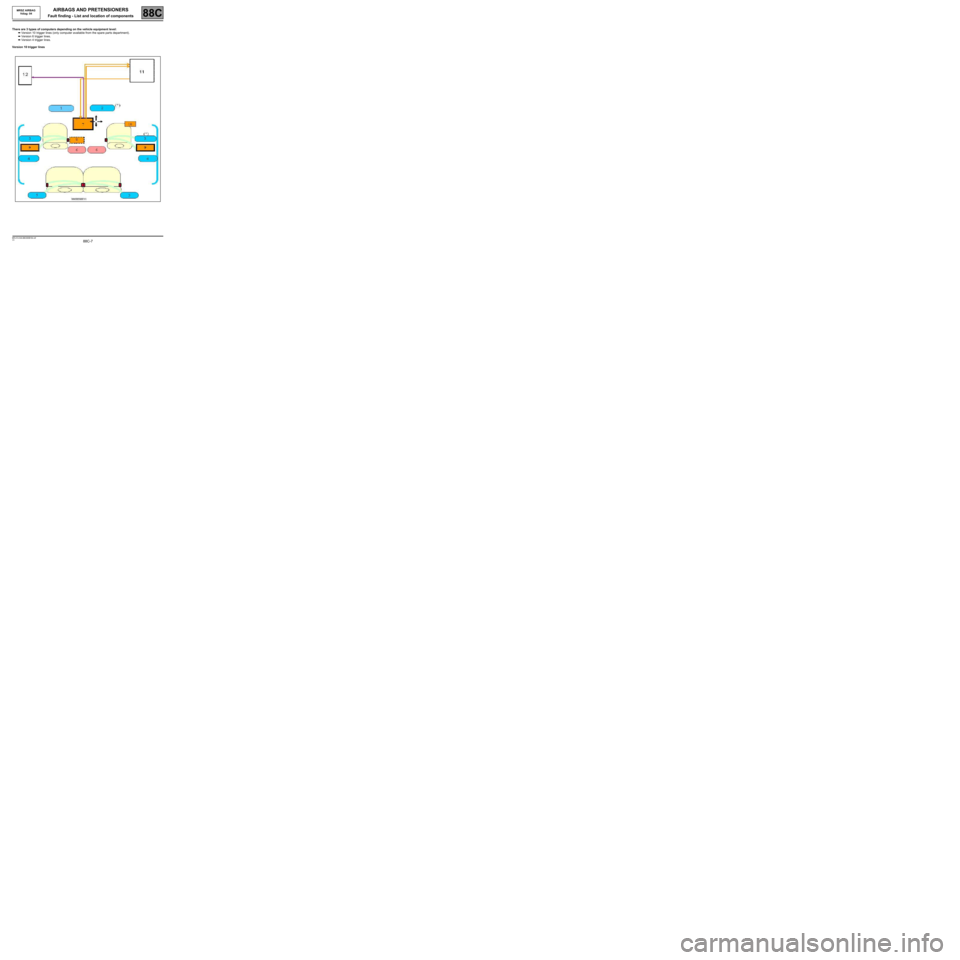
88C-7
MR-413-X44-88C000$154.mif
V3
88C
AIRBAGS AND PRETENSIONERS
Fault finding - List and location of components
There are 3 types of computers depending on the vehicle equipment level:
➡ Version 10 trigger lines (only computer available from the spare parts department).
➡ Version 6 trigger lines.
➡ Version 4 trigger lines.
Version 10 trigger lines
MR-413-X44-88C000$154.mif
MRSZ AIRBAG
Vdiag: 04
Page 8 of 67
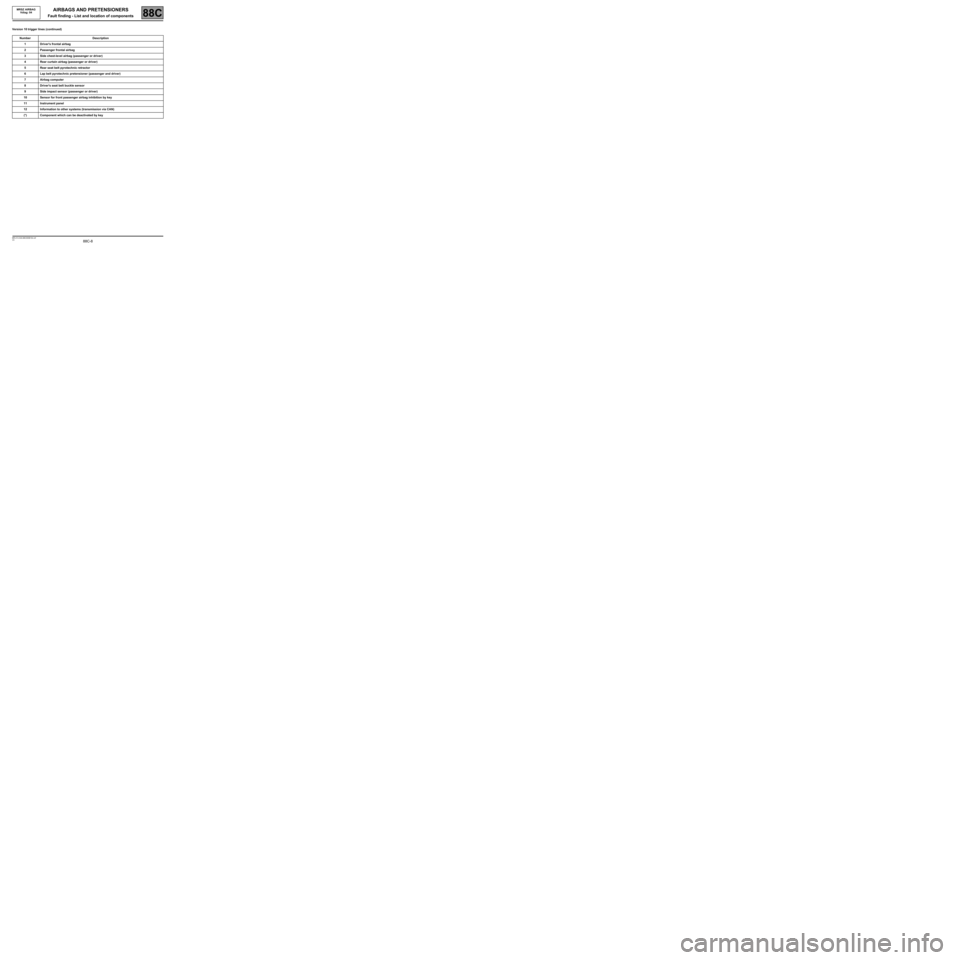
88C-8
MR-413-X44-88C000$154.mif
V3
MRSZ AIRBAG
Vdiag: 04AIRBAGS AND PRETENSIONERS
Fault finding - List and location of components88C
Version 10 trigger lines (continued)
Number Description
1Driver's frontal airbag
2Passenger frontal airbag
3Side chest-level airbag (passenger or driver)
4Rear curtain airbag (passenger or driver)
5Rear seat belt pyrotechnic retractor
6Lap belt pyrotechnic pretensioner (passenger and driver)
7Airbag computer
8Driver's seat belt buckle sensor
9Side impact sensor (passenger or driver)
10 Sensor for front passenger airbag inhibition by key
11 Instrument panel
12 Information to other systems (transmission via CAN)
(*) Component which can be deactivated by key
Page 9 of 67
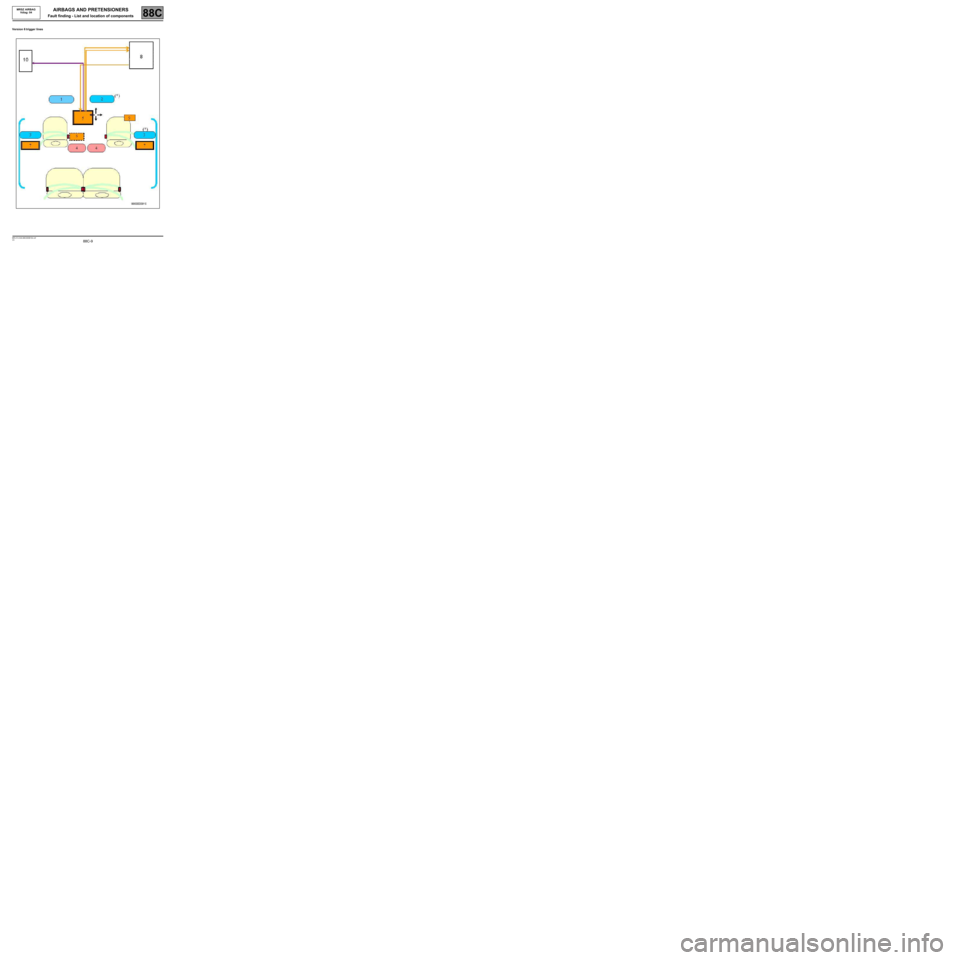
88C-9
MR-413-X44-88C000$154.mif
V3
MRSZ AIRBAG
Vdiag: 04AIRBAGS AND PRETENSIONERS
Fault finding - List and location of components88C
Version 6 trigger lines
Page 10 of 67
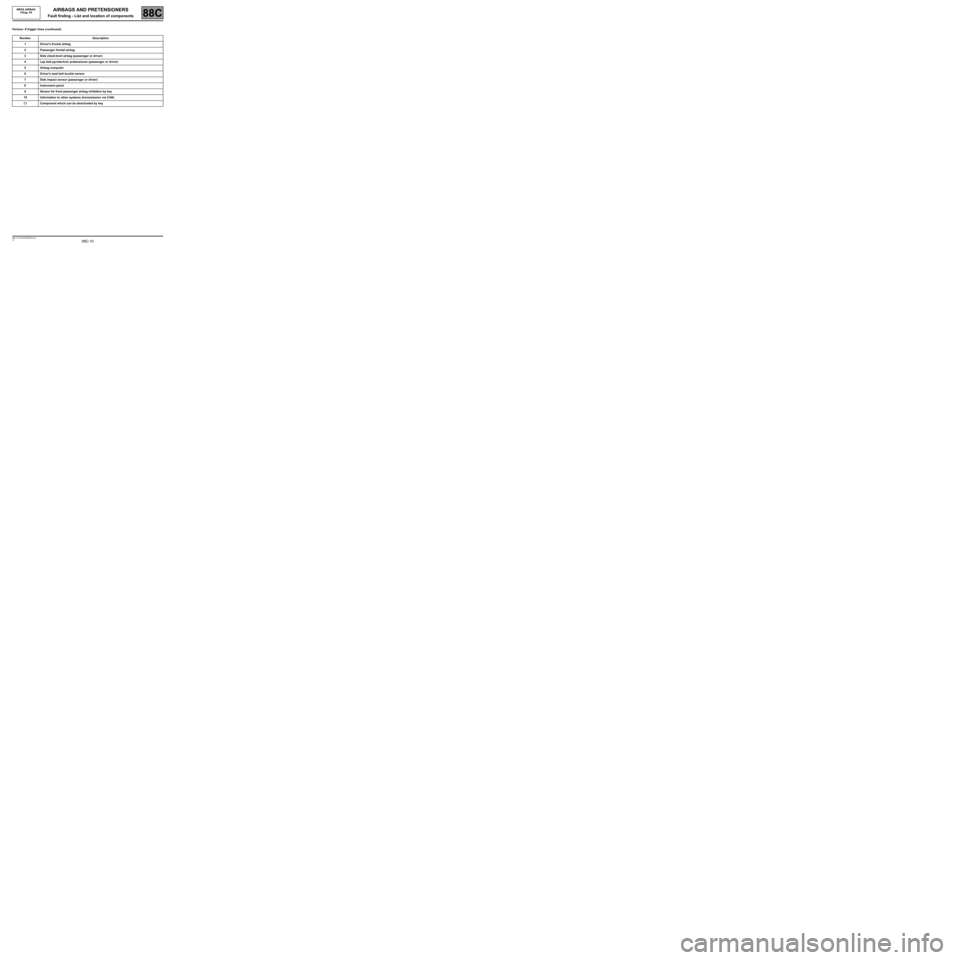
88C-10
MR-413-X44-88C000$154.mif
V3
MRSZ AIRBAG
Vdiag: 04AIRBAGS AND PRETENSIONERS
Fault finding - List and location of components88C
Version: 6 trigger lines (continued)
Number Description
1Driver's frontal airbag
2Passenger frontal airbag
3Side chest-level airbag (passenger or driver)
4Lap belt pyrotechnic pretensioner (passenger or driver)
5Airbag computer
6Driver's seat belt buckle sensor
7Side impact sensor (passenger or driver)
8Instrument panel
9Sensor for front passenger airbag inhibition by key
10 Information to other systems (transmission via CAN)
(*) Component which can be deactivated by key